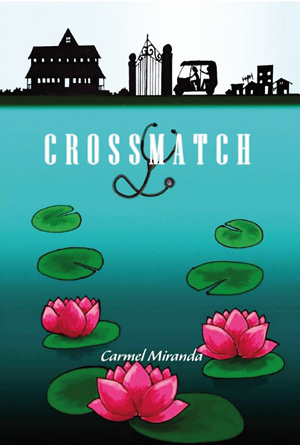A medical whodunnit that unravels much more
 Dr. Carmel Miranda did not want to do a Mayhem Parva (the genre of mysteries set in a rural English village). She did not really set out to emulate a long line of silver-haired ladies and write a nostalgic thriller. But as the whodunnit has today become so ubiquitous, with sub-genres like ‘culinary’ and ‘gardening’ inundating shelves, it seems inevitable that some not-so-fastidious critics have cast her debut novel, Crossmatch, as a cosy mystery, or a story where the joy lies solely in the suspense and being outwitted by the author at the end.
Dr. Carmel Miranda did not want to do a Mayhem Parva (the genre of mysteries set in a rural English village). She did not really set out to emulate a long line of silver-haired ladies and write a nostalgic thriller. But as the whodunnit has today become so ubiquitous, with sub-genres like ‘culinary’ and ‘gardening’ inundating shelves, it seems inevitable that some not-so-fastidious critics have cast her debut novel, Crossmatch, as a cosy mystery, or a story where the joy lies solely in the suspense and being outwitted by the author at the end.
The novel is really more than that, says Carmel, a medical professional, who used the time lying heavy on her hands during the first lockdown to challenge herself and produce a full blown book rather than scribblings here and there.
Like all writers should, she set out to write the kind of story she would have loved to read. It should, she decided, “be well-written, have an interesting plot (be it murder or anything else), and at the end, leave me thinking differently about larger issues or concerns that are raised in the story.”
She had in mind a mystery that was but a device for a more elevated story. She was inspired by Umberto Eco who provided ‘deep insights into his characters’ and ‘revelations about medieval history’- Daphne du Maurier with Rebecca, Charles Dickens with Oliver Twist or P. D. James who “wrote intricately plotted whodunits with well-developed, insightful characters, the prose so beautiful that when you read, you forget that these are detective stories.”
Crossmatch is thus a novel which makes you think, after reading, of a gamut of issues raised in the story.
The narrator and sleuth is Lotus, a student at the Colombo Medical Faculty. While the novel is a wonderful, pungent evocation of medical school as Carmel knew it, Lotus herself was not Carmel.

Carmel Miranda: Lockdown novel
Lotus is very middle class, a mite snobbish, prim but with a heart large enough to delve into the death under suspicious circumstances of a poor boy who was her aunt’s maid’s nephew.
Most of the action happens in the shadow of the medical faculty, and it is clear that Carmel had paid obsessive attention here- from the labour ward minutiae with witch-like midwives to teachers who are larger than life or ‘cadaverous’, the mortuary with its scary but fascinating specimens in formalin and green tiled basements where bodies lie under ‘arctic’ air conditioning and humming florescent lights. It is full of graphic medical descriptions from fetuses in the fallopian tube to gravid uteri- fascinating with the surgical detail.
Amusing as the bustle and the colourful human drama and rivalry within the medical faculty is, the novel at another level is a clever portrait of an institution voyeuristically put under the microscope.
But more than anything, it provides a vivid and brilliant picture of Sri Lanka’s medical community- from the ‘top consultants’ down to the attendants pushing the trolleys.
The story unfolds as Lotus, in the midst of busy rounds of lectures and appointments, gets inexorably sucked into the mystery of the boy’s death. While he is presumed to have been killed due to an accident, Lotus comes up against evidence that suggests otherwise. In a fast paced adventure she follows a trail of clues from the trauma unit to the mortuary and the slums of Wanathamulla to mansions of Cinnamon Gardens.
The book ultimately deals with ‘what happens when doctors think they are above the law’ says Carmel rather tantalizingly, hinting at what the denouement could be.
While Crossmatch is exciting for the Sri Lankan mystery lover for shifting the scene from Scotland Yard or St Mary Mead to Havelock Road and Borella, it is also compelling as a work of literature that deftly captures – thanks to a very observant pair of eyes – the inner workings of the most coveted profession within the country; in other words, a medical mystery with great content.



